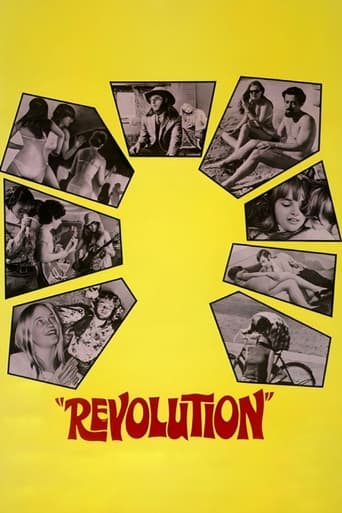slhakeman
This 1968 documentary (occasionally quasi-documentary) may seem to some nothing more than a disjointed mishmash of stoned loonies leaping around ad nauseam - and of course it is - but as one who lived through it, I'd have to say this is the best representation, in an hour and half at least, of the lunatic craziness, the ridiculous sense of barefooted freedom, and wide-eyed innocence that was "the hippie revolution" I've ever seen. It was totally unexpected.Sure most of the interviews are banal -though representative of the time - and much of the "freedom" demonstrated by all these middle class kids seems forced or false, and as a consequence laughable and clichéd now. But there's an essence captured here, due in large part I think to Jack McConnell just letting his camera rove around, that gives you at least a hint of the absolute excitement that electrified the scene for maybe a year and a half. And the end is foretold too, if you look closely enough - the drugs, of course, plus a lack of a cohesive philosophy, the unabashed panhandling, the growing divide between the musicians, who were still operating within the capitalist system and the bulk of the hippies who were vainly trying to escape the bonds represented by money, and the general naiveté. The best parts of the film: the music, especially Quicksilver Messenger Service, Country Joe & the Fish's "Section 43", the Charlatan's Dan Hicks' little acoustic ditty, and an actual clip of the Ace of Cups (arguably the first all female rock band) in concert. Also the fashions - as time slips away you forget just how outrageous and colorful they were at the start before everything went olive drab; those tight-lipped, smug representatives of authority who still make me want to leap through the screen with a flame thrower a la Harold Pinter; and that ineffably sad and nutty conversation between "Today" Malone and some guy about the genetic dangers of taking LSD. And sure, the naked girls romping through the tall grass seems clichéd today though it really wasn't so much back in '67 (or was it?), and the San Francisco Dance Troupe's performance goes on a tad too long, but I think this film gives a pretty good overview of what it was like back then, for good or bad, before it all went to hell.
Charles Herold (cherold)
Revolution is kind of interesting at first, just to see Haight Ashbury at the height of hippiedom, but the movie is so shapeless and rambling that by the last half hour I was fast forwarding through dozens of naked hippie chicks because I just couldn't take any more. It's also very strange to see a documentary with a star, in this case Today Malone. There are documentaries that focus on someone, but this seems more like the director had a crush on a girl and decided he would feature her in a movie so he could hang out with her, or something. One imagines the filmmakers were stoned while shooting and editing. Nothing has any sort of context and amazingly dull, stupid people are allowed to prattle on at great length. Still, watching the movie it does look like it would have been fun to be part of the whole thing.
thrillerclub
Jack O'Connell produced and directed this patchwork portrait of the hippie scene in 1967. The best parts are the rock band live performance sequences, although some of these clips were staged to appear as though they were filmed at ballroom dance concerts. Which is similar to what other films and TV shows at the time tended to do, rather than film an regularly scheduled club or ballroom dance concert with all the craziness of a real gig in full swing. PETULIA (1967) for example featured Janis Joplin with Big Brother & the Holding Co. performing at the unlikely venue of The Fairmont Hotel. PETULIA also captured The Grateful Dead playing on the dance floor - not even on a stage -in a very small club setting. REVOLUTION (later reedited and retitled THE HIPPIE REVOLUTION, briefly released theatrically in 1996) had a soundtrack album of studio takes that doesn't include all of or match versions of songs played live in the movie: Quicksilver Messenger Service are hard to make out in the dark, but perform a rousing "Codine" before the band is abruptly cut away from half way through the number; the all-girl band Ace of Cups perform "The Grass Is Greener" live in the park - sounding about as garage as any SF hippie rockumentary ever get; Dan Hicks of The Charlatans does an acoustic solo ditty called something like "He's Stoned" that's a nice rarity; and I'm not too wild about the footage of Country Joe & the Fish or the early Steve Miller Band but it is after all a hippie movie with Hare Krishnas and everything else that defined the wide-eyed idealism of the age.
Joe Stemme
REVOLUTION is a poorly shot, edited and produced picture. Nonetheless, it's a valuable document of the times, for it was shot real-time in San Francisco circa 1967. One can't get a better first-person eyewitness account of the era. As cinema, it's rather boring. The filmmakers meander all around town filming (sometimes endlessly) whatever they see, and, more importantly, WHOever they can talk to. Some of the footage is priceless and real. Others, like an acid trip dressed up with panning and zooming camerawork revolving around Fruits, Feet and a Cat (you GOTTA see it to believe it!) is hilarious in its ineptitude. For those interested in the era, this is a historical must. Others, beware.


